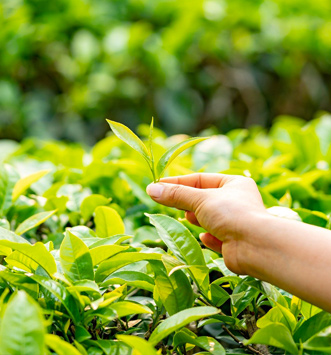
Tea lovers, whether you prefer bagged or loose tea, many of you wonder: how is organic tea picked? What is its impact on the environment and in your cup? What are the major differences from plantation to mug? Regardless of the tea plant's origin, the most important thing is to respect Ecocert's specifications. This involves specific control measures and the prohibition of pesticide use. Discover the particularities of organic tea cultivation and harvesting, from plantation to tasting.
The particularities of organic tea picking from plantation to import
From Japan, China or Sri Lanka, tea cultivation can have a negative impact on the environment and the consumer. Choosing to consume products from organic farming is above all respecting the planet. This ensures a product quality as pure as possible for tasting.
In order to preserve the natural aromas of tea as much as possible, it is essential to cultivate tea plants without pesticides. To limit the appearance of diseases on the tea plant caused by pests or poor soil quality, Ecocert requires the use of 95% natural ingredients as pesticides.
Cultivation methods without chemicals improve the content of tannin, caffeine and aromas present in whole tea leaves. To do this, producers use entirely plant-based methods of protecting plants and soils. By using straw to preserve the mineral content of soils, and certain plants to repel insects, they choose eco-responsible agriculture.
Regarding harvesting, the frequency varies depending on the geographical location: in Indonesia and Sri Lanka, harvesting is carried out all year round depending on the humidity level. While green teas from China and India are picked from April to November. The picking is exclusively done by women, while planting and production are reserved for men.
Even if large producers use accessories and tools for harvesting, it is preferable to pick by hand, in order not to damage the whole leaves.
The benefits of organic tea picking for tasting
Fine picking involves harvesting young whole leaf shoots around the bud, also called pekoe. They are rich in tannins and flavors. Imperial picking is done with gloves and by women, known for having delicate hands. This is the harvest of pekoe, rich in essential oils.
Organic tea leaves offer different aromas and fragrances depending on their position on the tea plant, their size and color. Producers carry out several types of harvests to offer consumers a range of different tastes.
In terms of taste, the quality of organic tea makes a big difference compared to non-organic tea. Indeed, the leaves and buds are never washed. This means that infusing your teas and herbal teas is not enough to eliminate the pesticides used in tea plant cultivation.
Moreover, its natural aromas and nutritional power are considerably reduced. For example, a Chinese Sencha green earl grey tea will be completely devoid of its antioxidant and anti-inflammatory properties.
Tea harvesting: a gourmet and eco-responsible choice
Organic tea picking follows the same general lines as non-organic tea harvesting. The difference is made in planting and production. Whether loose or in bags, your tea will be impacted by the use of chemical fertilizers during cultivation. If you are a fan of gourmet teas and looking for an explosion of fruity flavors, choose organic loose tea.
Discover our other articles on the topic of organic tea: